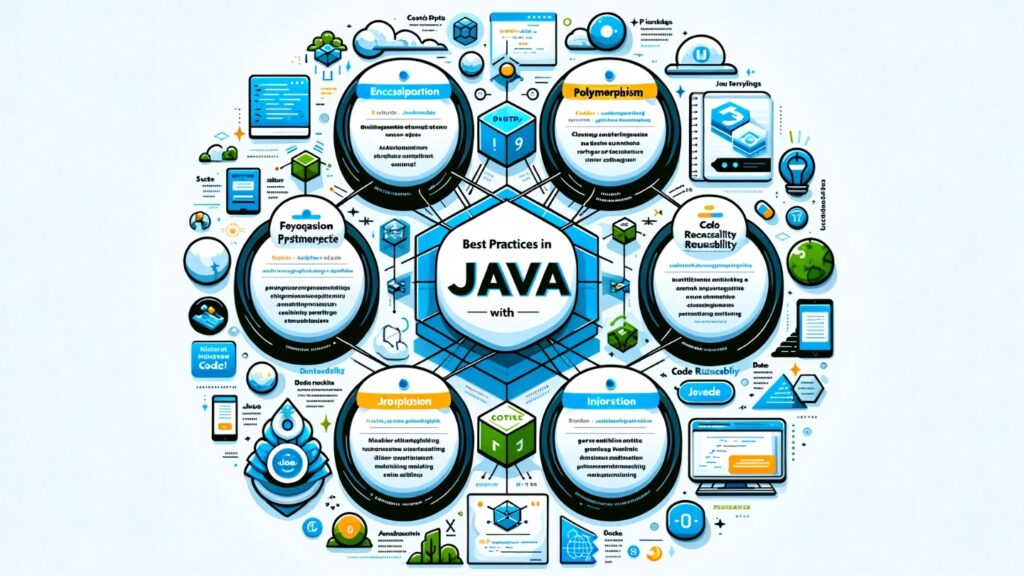Object-Oriented Programming (OOP) is a programming paradigm centered around objects rather than functions and procedures. Unlike procedural programming, which focuses on writing procedures or functions that perform operations on the data, OOP bundles the data and the functions that operate on the data into objects. This approach is instrumental in developing large, complex software systems and applications.
Java, a robust and versatile programming language, stands out as a premier environment for implementing OOP principles. It offers a clear and concise syntax, a vast library of pre-written classes and interfaces, and strong memory management capabilities, making it an ideal choice for both beginner and experienced programmers.
Key Principles of OOP in Java
- Encapsulation: This principle is about bundling the data (variables) and the methods (functions) that operate on the data into single units called classes. Encapsulation also involves restricting direct access to some of an object’s components, which is a means of preventing accidental interference and misuse of the methods and data.
- Inheritance: This principle allows a new class to inherit the properties and methods of an existing class. Inheritance facilitates code reuse and can lead to an improvement in the logical structure of the code.
- Polymorphism: This principle allows objects of different classes to be treated as objects of a common superclass. It’s a technique that lets a function or method operate on many different types of data.
- Abstraction: This principle involves hiding complex implementation details and showing only the necessary features of an object. Abstraction helps in reducing programming complexity and effort.
Importance of Java in OOP
Java’s design is inherently object-oriented, which means every program and piece of data resides within an object or a class. The language’s architecture encourages developers to think in terms of objects, fostering a more natural and manageable coding process. This object-centric approach is not just a part of the syntax but is deeply integrated into the design of Java’s APIs and libraries.
Moreover, Java’s platform independence – “write once, run anywhere” – adds to its allure in the OOP domain. The Java Virtual Machine (JVM) enables Java programs to run on any device or operating system, making Java a universally preferred language for developers around the world.
Java Classes and Objects: The Building Blocks
Classes and objects are fundamental concepts in Java’s Object-Oriented Programming. A class in Java is a blueprint for creating objects. It defines a datatype by bundling data and methods into a single unit. An object is an instance of a class, embodying the properties and behaviors defined by the class.
Defining Classes in Java
A class is defined using the class keyword. It typically contains data members (variables) and methods (functions) that operate on the data. The data members represent the state of an object, and the methods define its behavior.
Here is an example of a simple Java class:
public class Car {
// Data members
String brand;
int year;
// Constructor
public Car(String brand, int year) {
this.brand = brand;
this.year = year;
}
// Method
public void displayInfo() {
System.out.println("Car Brand: " + brand + ", Year: " + year);
}
}
In this example, Car is a class with two data members (brand and year) and a method (displayInfo). The Car class also includes a constructor, which is a special method used to initialize objects.
Creating Objects in Java
Objects are instances of a class created using the new keyword. Each object has its own copy of the class’s attributes and can invoke its methods.
Creating an object of the Car class:
public class Main {
public static void main(String[] args) {
Car myCar = new Car("Toyota", 2020);
myCar.displayInfo();
}
}
In this code snippet, myCar is an object of the Car class. The new keyword is used to instantiate the object, and the constructor Car("Toyota", 2020) initializes the object’s state.
Constructors and Destructors
- Constructors: Constructors are special methods in Java used to initialize new objects. They have the same name as the class and may take parameters.
- Destructors: Unlike languages like C++, Java does not have destructors. Instead, it relies on Garbage Collection to automatically manage memory. When no references to an object remain, the Java Garbage Collector automatically deallocates the memory used by the object.
Java’s approach to classes and objects simplifies the creation and management of complex data types. By using classes as blueprints, developers can create multiple objects with the same structure but independent states, leading to code that is more organized and easier to manage.
Encapsulation: Protecting Data in Java

Encapsulation is a fundamental principle of Object-Oriented Programming in Java, focusing on restricting access to certain components of an object and only allowing controlled modifications. It is achieved using access modifiers and methods to encapsulate the data within objects.
Access Modifiers in Java
Access modifiers determine the scope of accessibility of classes, methods, and variables. Java provides several access modifiers:
- public: The member is accessible from any other class.
- private: The member is accessible only within its own class.
- protected: The member is accessible within its own package and by subclasses.
- default (no modifier): The member is accessible within its own package.
Implementing Encapsulation with Getters and Setters
Encapsulation typically involves making class variables private and providing public getter and setter methods to access and modify these variables. This approach allows for controlled access to the internal state of an object.
Here’s an example demonstrating encapsulation:
public class Person {
private String name; // Private variable
// Constructor
public Person(String name) {
this.name = name;
}
// Getter method
public String getName() {
return name;
}
// Setter method
public void setName(String name) {
this.name = name;
}
}
public class Main {
public static void main(String[] args) {
Person person = new Person("Alice");
System.out.println("Name: " + person.getName()); // Accessing via getter
person.setName("Bob"); // Modifying via setter
System.out.println("Updated Name: " + person.getName());
}
}
In this example, the Person class has a private variable name. The getName and setName methods are the public getter and setter methods, respectively. They provide controlled access to the name variable.
Encapsulation enhances data security and integrity by hiding the internal state of objects. By restricting direct access to the class fields, encapsulation reduces the risk of unintended interference and misuse of the class’s internal workings, promoting more robust and maintainable code.
Inheritance: Extending Functionality in Java
Inheritance is a key concept in Java’s Object-Oriented Programming that allows a new class to inherit properties and methods from an existing class. This mechanism facilitates code reuse and the creation of a hierarchical relationship between classes.
Understanding Inheritance in Java
In Java, when a class inherits from another class, it gains access to the parent class’s protected and public methods and variables. The class that inherits is known as the subclass or derived class, and the class from which it inherits is called the superclass or base class.
Syntax and Use of Inheritance
Inheritance in Java is implemented using the extends keyword. Here’s an example to illustrate:
// Superclass
class Vehicle {
protected String brand = "Ford"; // Vehicle attribute
public void honk() { // Vehicle method
System.out.println("Tuut, tuut!");
}
}
// Subclass (inherit from Vehicle)
class Car extends Vehicle {
private String modelName = "Mustang"; // Car attribute
public static void main(String[] args) {
// Create a Car object
Car myCar = new Car();
// Call the honk() method (from the Vehicle class) on the Car object
myCar.honk();
// Display the value of the brand attribute (from the Vehicle class) and the value of the modelName from the Car class
System.out.println(myCar.brand + " " + myCar.modelName);
}
}
In this example, Car is a subclass of Vehicle. The Car class inherits the brand property and the honk() method from Vehicle.
Advantages of Inheritance
Inheritance offers several benefits:
- Code Reuse: By inheriting common properties and methods from a superclass, you can avoid code duplication.
- Maintainability: Changes in the superclass automatically propagate to subclasses, which simplifies maintenance.
- Polymorphism: Inheritance is a prerequisite for polymorphism, allowing a single operation to be performed in different ways on different classes.
Inheritance in Java simplifies the development process by enabling developers to create a new class that inherits attributes and methods from an existing class. This not only promotes code reuse but also enhances the organizational clarity and maintainability of the code.
Polymorphism: Dynamic Method Invocation

Polymorphism, a cornerstone of Object-Oriented Programming in Java, allows objects to be treated as instances of their parent class rather than their actual class. The power of polymorphism lies in its ability to process objects differently depending on their actual class, which is determined at runtime.
Understanding Polymorphism in Java
Polymorphism in Java comes in two main forms: compile-time polymorphism (method overloading) and runtime polymorphism (method overriding).
- Method Overloading (Compile-time Polymorphism): This occurs when two or more methods in the same class have the same name but different parameters.
- Method Overriding (Runtime Polymorphism): This happens when a subclass provides a specific implementation for a method already defined in its superclass.
Example of Method Overloading
Method overloading allows a class to have more than one method with the same name, as long as their parameter lists are different.
class DisplayOverload {
public void display(char c) {
System.out.println(c);
}
public void display(char c, int num) {
for(int i = 0; i < num; i++) {
System.out.println(c);
}
}
}
public class Main {
public static void main(String[] args) {
DisplayOverload obj = new DisplayOverload();
obj.display('a');
obj.display('a', 3);
}
}
In this example, the DisplayOverload class has two display methods: one that takes a single character and another that takes a character and an integer. The method to be invoked is determined at compile time based on the method signature.
Example of Method Overriding
Method overriding occurs when a subclass provides a specific implementation for a method already defined in its parent class.
// Superclass
class Animal {
public void sound() {
System.out.println("Animal is making a sound");
}
}
// Subclass
class Dog extends Animal {
@Override
public void sound() {
System.out.println("Barking");
}
}
public class Main {
public static void main(String[] args) {
Animal myAnimal = new Dog();
myAnimal.sound();
}
}
In this example, the Dog class overrides the sound method of its superclass Animal. When the sound method is called on an object of class Dog, the overridden method in Dog is executed, demonstrating runtime polymorphism.
Benefits of Polymorphism
- Flexibility: It allows for flexible and reusable code. A single method can operate on objects of different classes.
- Scalability: It makes it easier to add new classes that use the same interface, making the code more scalable.
- Simplicity: It simplifies the code by allowing one interface to be used to specify a general set of actions.
Polymorphism enhances the capability of Java programs by enabling a level of abstraction and flexibility in method invocation. It forms the foundation for many powerful programming concepts and design patterns in Java, contributing significantly to the effectiveness and scalability of Java applications.
Abstraction: Simplifying Complexity
Abstraction in Java is a process that involves hiding the complex implementation details and exposing only the necessary functionalities. It is achieved through abstract classes and interfaces, which are used to declare methods that must be implemented by the subclass.
Abstract Classes in Java
An abstract class in Java is a class that cannot be instantiated and is often used as a base class. Abstract classes may contain both abstract methods (without an implementation) and concrete methods (with an implementation).
abstract class Animal {
// Abstract method (does not have a body)
public abstract void animalSound();
// Regular method
public void sleep() {
System.out.println("Zzz");
}
}
class Pig extends Animal {
public void animalSound() {
// The body of animalSound() is provided here
System.out.println("The pig says: wee wee");
}
}
public class Main {
public static void main(String[] args) {
Pig myPig = new Pig(); // Create a Pig object
myPig.animalSound();
myPig.sleep();
}
}
In this example, Animal is an abstract class with an abstract method animalSound and a concrete method sleep. Pig is a subclass of Animal and provides an implementation for the animalSound method.
Interfaces in Java
An interface in Java is a completely abstract class that is used to group related methods with empty bodies.
interface Animal {
public void animalSound(); // interface method (does not have a body)
public void sleep(); // interface method (does not have a body)
}
// Pig "implements" the Animal interface
class Pig implements Animal {
public void animalSound() {
// The body of animalSound() is provided here
System.out.println("The pig says: wee wee");
}
public void sleep() {
// The body of sleep() is provided here
System.out.println("Zzz");
}
}
public class Main {
public static void main(String[] args) {
Pig myPig = new Pig(); // Create a Pig object
myPig.animalSound();
myPig.sleep();
}
}
In this example, Animal is an interface with two methods animalSound and sleep. The Pig class implements the Animal interface and provides the implementation for both methods.
Benefits of Abstraction
- Simplicity: Abstraction simplifies the understanding of what an object does.
- Modularity: It separates the functionality of class implementation and usage.
- Extensibility: Abstract classes and interfaces allow for flexible and extensible code, as new classes can be added with minimal changes to the existing code.
Abstraction is a key principle in Java that allows programmers to focus on what an object does rather than how it does it, thereby reducing complexity and increasing the efficiency of the design.
Best Practices in OOP with Java

Adhering to best practices in Object-Oriented Programming, especially in Java, is crucial for writing clean, maintainable, and efficient code. Here are some key practices to consider.
Use Proper Class and Package Design
Well-structured classes and logical package organizations are vital. Classes should be designed with a single responsibility and clear purpose. Packages should group related classes to enhance readability and maintainability.
Encapsulate Class Data and Behaviors
Encapsulation is not just about using private variables and public getters/setters; it’s about ensuring that classes control their own data and behaviors, promoting loose coupling and high cohesion.
Take Advantage of Inheritance and Polymorphism
While inheritance is a powerful tool for code reuse and polymorphism aids in flexible method invocation, overusing inheritance can lead to complex and fragile code hierarchies. Use these features judiciously.
Use Interfaces and Abstract Classes Appropriately
Interfaces and abstract classes are excellent for defining contracts and common behaviors. Use interfaces for defining capabilities and abstract classes for sharing common implementations.
Handle Exceptions Correctly
Proper exception handling is critical for robust applications. Avoid generic catch-all exception handlers; instead, handle specific exceptions to provide meaningful error recovery.
Follow Naming and Coding Conventions
Adhering to standard Java naming and coding conventions makes your code more understandable and maintainable.
Utilizing Design Patterns and Refactoring Techniques
Familiarize yourself with common design patterns in OOP. These patterns provide tested solutions to common design problems. Regular refactoring helps in improving the design of existing code, making it easier to understand and modify.
Example: Implementing a Design Pattern
One popular design pattern in Java is the Singleton pattern, which ensures that a class has only one instance and provides a global point of access to it.
public class Singleton {
// Private static variable of the same class that is the only instance of the class
private static Singleton singleInstance = null;
// Private constructor to restrict instantiation of the class from other classes
private Singleton() {
}
// Static method to create instance of Singleton class
public static Singleton getInstance() {
if (singleInstance == null)
singleInstance = new Singleton();
return singleInstance;
}
}
public class Main {
public static void main(String[] args) {
// Instantiating Singleton class with variable x
Singleton x = Singleton.getInstance();
// Instantiating Singleton class with variable y
Singleton y = Singleton.getInstance();
// Instantiating Singleton class with variable z
Singleton z = Singleton.getInstance();
// Printing the hash code for x, y, z
System.out.println("Hashcode of x is " + x.hashCode());
System.out.println("Hashcode of y is " + y.hashCode());
System.out.println("Hashcode of z is " + z.hashCode());
// Condition check
if (x == y && y == z) {
// Print statement
System.out.println("Three objects point to the same memory location on the heap i.e, to the same object");
} else {
// Print statement
System.out.println("Three objects DO NOT point to the same memory location on the heap");
}
}
}
In this example, Singleton class ensures that only one instance of the class is created, and the getInstance method provides a way to access that instance.
Adopting these best practices in Java OOP leads to cleaner, more efficient, and more maintainable code, making it easier for developers to manage complex software projects.
Conclusion: Harnessing the Power of Java OOP
In conclusion, Object-Oriented Programming in Java offers a robust framework for building scalable, maintainable, and efficient software. The core principles of OOP – encapsulation, inheritance, polymorphism, and abstraction – are not just theoretical concepts but practical tools that, when used effectively, can significantly enhance the quality and functionality of code. Java’s implementation of these principles, combined with its robust standard libraries and platform independence, makes it a powerful language for object-oriented design. The encapsulation of data and methods within classes ensures secure and organized code, while inheritance and polymorphism facilitate code reuse and flexibility. Abstraction, on the other hand, simplifies complex operations, making the codebase more intuitive and manageable.
Moreover, adhering to best practices in Java OOP, such as proper class and package design, effective use of interfaces and abstract classes, correct handling of exceptions, and following coding conventions, is crucial for creating high-quality software. Implementing design patterns like Singleton and consistently refactoring code further contribute to the development of robust applications. As Java continues to evolve, staying updated with these principles and practices is key for developers to harness the full potential of OOP in building advanced, reliable, and high-performing applications. The journey through understanding and applying Java’s OOP capabilities is both challenging and rewarding, opening doors to a vast landscape of software development opportunities.




